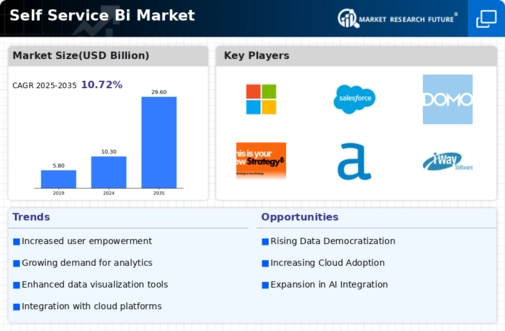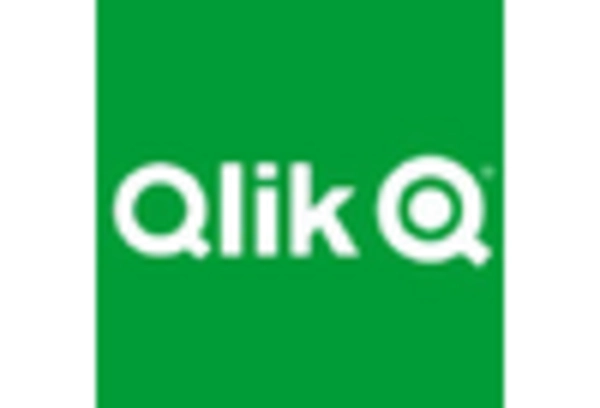Emphasis on Data Governance
In the Self Service BI Market, there is a growing emphasis on data governance as organizations strive to ensure data quality and compliance. As self-service tools become more prevalent, the risk of data mismanagement increases, prompting businesses to implement robust governance frameworks. This focus on governance not only protects sensitive information but also enhances the credibility of insights derived from self-service BI tools. Recent studies indicate that organizations with strong data governance practices are 50% more likely to achieve their analytics objectives. Therefore, the Self Service BI Market is adapting to these needs by offering solutions that incorporate governance features, ensuring that users can trust the data they are working with while maintaining compliance with regulatory standards.
Increased Focus on Cost Efficiency
Cost efficiency is becoming a critical driver in the Self Service BI Market as organizations seek to optimize their analytics expenditures. With the rising costs associated with traditional BI solutions, businesses are turning to self-service options that offer more affordable alternatives. Market analysis indicates that self-service BI tools can reduce analytics costs by up to 40%, making them an attractive choice for organizations of all sizes. This focus on cost efficiency is prompting vendors to innovate and provide scalable solutions that cater to diverse business needs. Consequently, the Self Service BI Market is likely to see continued growth as companies prioritize budget-friendly analytics solutions that do not compromise on functionality or performance.
Integration of Advanced Technologies
The Self Service BI Market is increasingly influenced by the integration of advanced technologies such as artificial intelligence and machine learning. These technologies enhance the capabilities of self-service BI tools, enabling users to derive deeper insights from their data. For instance, AI-driven analytics can automate data preparation and provide predictive insights, which significantly reduces the time required for analysis. As organizations seek to leverage their data more effectively, the demand for self-service BI solutions that incorporate these technologies is likely to rise. Market data suggests that the adoption of AI in BI tools could lead to a 30% increase in efficiency for data analysis tasks. Consequently, the Self Service BI Market is poised for growth as businesses recognize the value of integrating advanced technologies into their analytics processes.
Rising Demand for Real-Time Analytics
The Self Service BI Market is witnessing a rising demand for real-time analytics, driven by the need for timely decision-making in fast-paced business environments. Organizations are increasingly recognizing the importance of accessing up-to-date data to respond swiftly to market changes and customer needs. This trend is reflected in market data, which shows that the demand for real-time BI solutions is expected to grow by over 25% in the coming years. As a result, self-service BI tools are evolving to provide real-time data access and visualization capabilities, allowing users to make informed decisions based on the latest information. The Self Service BI Market is thus adapting to this demand, ensuring that businesses can leverage real-time insights to maintain a competitive edge.
User Empowerment through Intuitive Interfaces
The Self Service BI Market is experiencing a notable shift towards user empowerment, driven by the development of intuitive interfaces. These interfaces allow non-technical users to engage with data analytics tools without requiring extensive training. As a result, organizations are witnessing increased adoption rates among employees, leading to a more data-driven culture. According to recent data, the market for self-service BI tools is projected to grow at a compound annual growth rate of approximately 20% over the next five years. This trend indicates that businesses are prioritizing user-friendly solutions to enhance productivity and decision-making capabilities. The Self Service BI Market is thus evolving to meet the demands of a diverse user base, fostering an environment where data insights are accessible to all levels of an organization.


















Leave a Comment